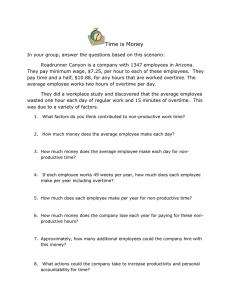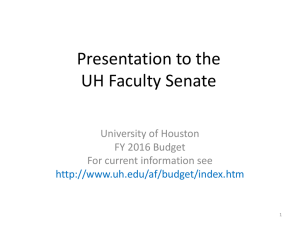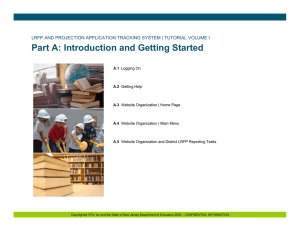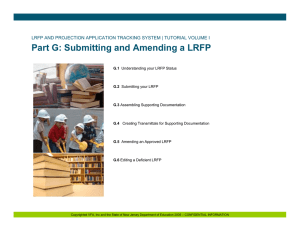Provost's Advisory Council Summary of October 29, 2009 meeting Bert Garza
advertisement
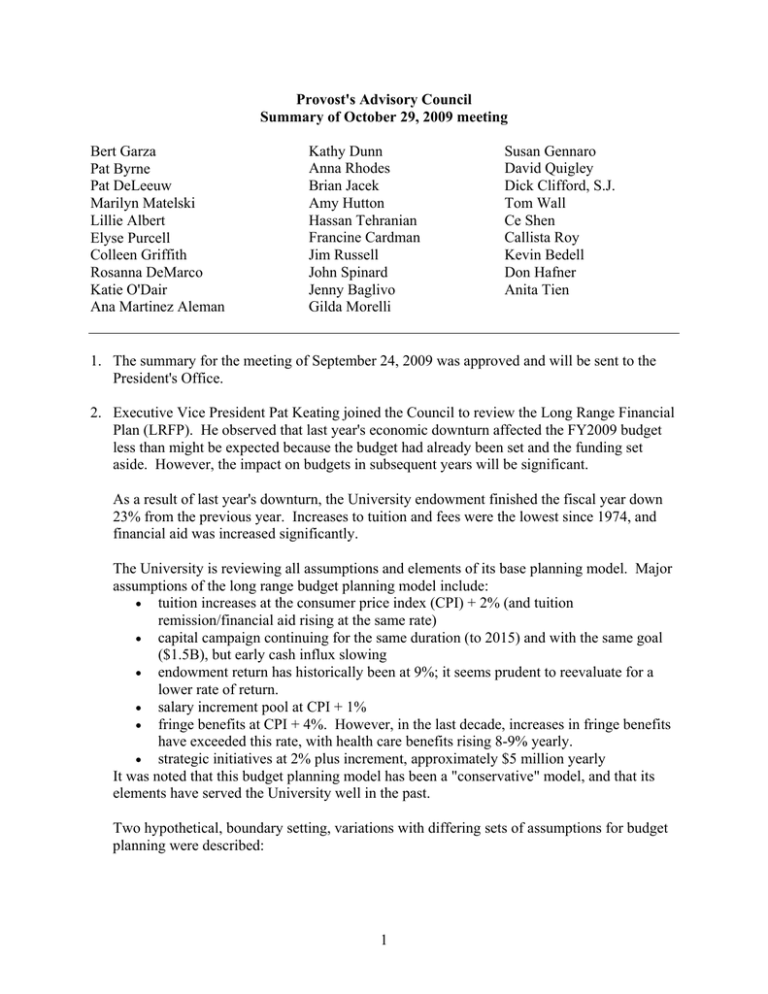
Provost's Advisory Council Summary of October 29, 2009 meeting Bert Garza Pat Byrne Pat DeLeeuw Marilyn Matelski Lillie Albert Elyse Purcell Colleen Griffith Rosanna DeMarco Katie O'Dair Ana Martinez Aleman Kathy Dunn Anna Rhodes Brian Jacek Amy Hutton Hassan Tehranian Francine Cardman Jim Russell John Spinard Jenny Baglivo Gilda Morelli Susan Gennaro David Quigley Dick Clifford, S.J. Tom Wall Ce Shen Callista Roy Kevin Bedell Don Hafner Anita Tien 1. The summary for the meeting of September 24, 2009 was approved and will be sent to the President's Office. 2. Executive Vice President Pat Keating joined the Council to review the Long Range Financial Plan (LRFP). He observed that last year's economic downturn affected the FY2009 budget less than might be expected because the budget had already been set and the funding set aside. However, the impact on budgets in subsequent years will be significant. As a result of last year's downturn, the University endowment finished the fiscal year down 23% from the previous year. Increases to tuition and fees were the lowest since 1974, and financial aid was increased significantly. The University is reviewing all assumptions and elements of its base planning model. Major assumptions of the long range budget planning model include: tuition increases at the consumer price index (CPI) + 2% (and tuition remission/financial aid rising at the same rate) capital campaign continuing for the same duration (to 2015) and with the same goal ($1.5B), but early cash influx slowing endowment return has historically been at 9%; it seems prudent to reevaluate for a lower rate of return. salary increment pool at CPI + 1% fringe benefits at CPI + 4%. However, in the last decade, increases in fringe benefits have exceeded this rate, with health care benefits rising 8-9% yearly. strategic initiatives at 2% plus increment, approximately $5 million yearly It was noted that this budget planning model has been a "conservative" model, and that its elements have served the University well in the past. Two hypothetical, boundary setting, variations with differing sets of assumptions for budget planning were described: 1 A high-revenue, low-expense variation, which would lead to a projected surplus of approximately $30 million by FY2015 and $100 million by FY2020. Under this model, there would be no strategic initiatives or capital expenses incurred. A second variation, with low revenue and high-expense assumptions, would lead to a projected deficit of $61 million by FY2015 and $100 million by FY2020. This model assumes the implementation of all strategic plan initiatives and capital expenses, with tuition increases remaining at CPI. Between these two extremes is a difference of $100 million by FY2015 and $200 million by FY2020. In December and again in February, the Trustees will discuss the assumptions governing these models and will review the LRFP. Tuition, financial aid, and capital projects--the areas with greatest impact on the budget--will be reviewed with an eye toward maintaining the strategic goals of the University: to continue academic momentum, have a balanced budget, meet enrollment targets on a need-blind basis, and meet the full demonstrated need of students. Patrick Rombalski joined the Council to address the opening days of the school year, before classes begin. A small committee that includes members from Student Affairs and the Provost's Office has been constituted to examine the opening days. Recent innovations include an "Opening Welcome" by the University and weekend programs to help students make the adjustment to college and to promote positive transitions and socialization. The goal is to ensure that these initial days on campus are conducive to student learning. Dr. Rombalski noted that this year’s programming represented an inaugural effort, and that programming would be expanded and likely refocused in future years, perhaps to include discussions on academic integrity, workshops on issues of diversity, and conversations about the role and value of the Core. It was observed that this year's programming did not begin until 5:00 pm, a time that was helpful in discouraging negative behaviors in the evening, but that left students on their own during the day. Daytime activities could include faculty-led excursions to cultural and historical sites of interest in Boston. It was observed that the parent portion of summer Orientation sessions includes an opportunity for parents to hear from a student panel. It has been observed that there is very little academic content mentioned by the students--no mention of faculty, of an advisor, of classes, of reading. It was suggested that some of the time for students could be spent in proximity to faculty. Others noted that it may be intimidating for new students to be around faculty. One possible approach was suggested--to take existing successful programs (such as PULSE) and appropriate them as models for implementation during opening days. It was suggested that information about health and wellness for students could also be presented during these days. Members are asked to send additional comments about the opening days and student programs directly to Patrick Rombalski. 2 3. Leo Sullivan and Bob Lewis joined the Provost's Advisory Council to provide information about the University's negotiations with the Service Employees International Union, Local 615, with a membership of 270 employees in Facilities Services. The current language of the contract constrains the University from engaging vendors and/or subcontractors for tasks currently performed at overtime rates for regular employees. There is no current limit on overtime for employees, and for emergency needs (e.g., clearing snow during and after storms), overtime expenses are expected. For scheduled events (e.g., picking up debris after football games), the University would prefer to have the flexibility to hire subcontractors, an option that is viewed as more financially efficient than the current practice of paying overtime to regular employees. Some in the University have been concerned that this is the beginning of an outsourcing effort, and that current employees will lose their jobs. BC has assured the union members that employees will be guaranteed their jobs and a 40-hour work week. The University is seeking only to reduce overtime costs. 4. Bert Garza asked Provost's Advisory Council members to remind their departments that the course/teaching evaluations will be available online to students and faculty, beginning with the registration period in November. Council members were reminded that, as was the case last year, University funds should not be used for funding holiday parties. 3





